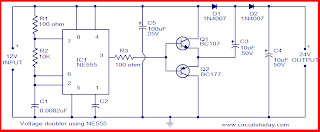ENGLISH and INDONESIAN

>< The circuit diagram shown here is of a 2 x 60 Watt stereo amplifier based on the LM4780 from National Semiconductors. LM4780 is a superb audio amplifier IC capable of delivering 60W Rms power output / channel into 8 ohm speakers. The LM4780 has very low total harmonic distortion (less than 0.5% at full output) and has a power supply rejection ration (PSRR) of 85 dB. The IC requires very few external components and has a built in mute facility. The LM4780 is completely protected using their trademark SPiKe technology and has a signal to noise ratio greater than 97dB. The circuit given here is well suitable for applications like components stereos, self powered speakers, home theatre systems, compact stereos etc.
>< Diagram rangkaian yang ditunjukkan di sini adalah sebuah penguat stereo 2 60 Watt x berdasarkan LM4780 dari Semikonduktor Nasional. LM4780 adalah IC penguat audio yang luar biasa mampu memberikan 60W RMS daya saluran keluaran / menjadi 8 ohm speaker. LM4780 ini memiliki distorsi yang sangat rendah harmonik total (kurang dari 0,5% pada output penuh) dan memiliki power supply ransum penolakan (PSRR) dari 85 dB. IC memerlukan komponen eksternal sangat sedikit dan memiliki built in fasilitas bisu. LM4780 ini benar-benar dilindungi dengan menggunakan merek dagang mereka teknologi Spike dan memiliki sinyal to noise ratio lebih besar dari 97dB. Rangkaian yang diberikan di sini sangat cocok untuk aplikasi seperti komponen stereo, speaker bertenaga diri, sistem home theater, stereo kompak dll
Catatan.
Rangkaian harus dirakit pada kualitas PCB yang baik.
Penguat dapat diaktifkan menggunakan suplai DC 35V ganda.
K1 dan K2 harus 8 ohm, speaker 60W.
Sebuah heat sink berukuran memadai harus dipasang ke IC.
Catatan.
Rangkaian harus dirakit pada kualitas PCB yang baik.
Penguat dapat diaktifkan menggunakan suplai DC 35V ganda.
K1 dan K2 harus 8 ohm, speaker 60W.
Sebuah heat sink berukuran memadai harus dipasang ke IC.
source circuitstoday

























